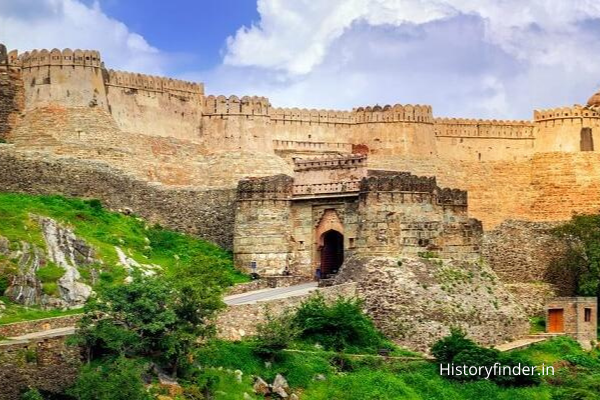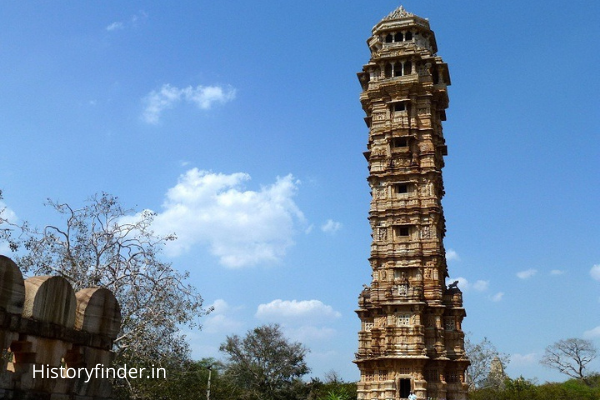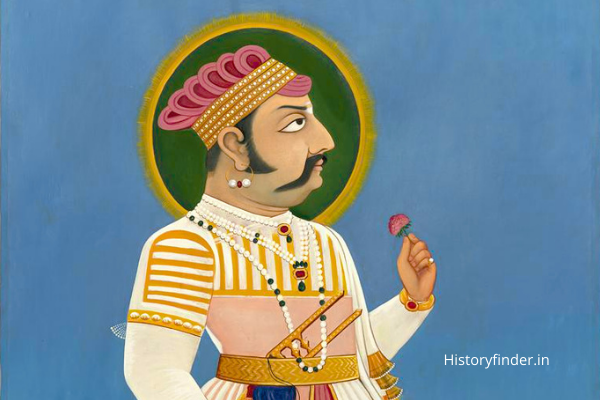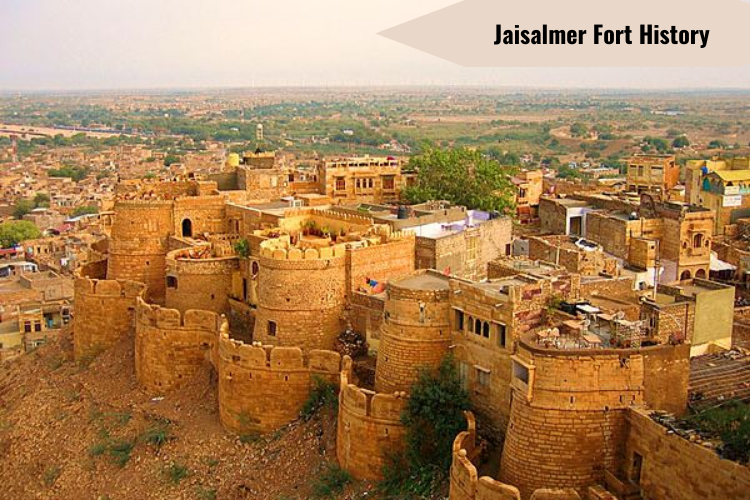Bikaner city of Rajasthan is rich in many historical forts and palaces. But Junagarh Fort, perhaps the city’s most important historical landmark, appears right at its center. Junagarh Fort counts as one of the most beautifully decorated forts in India and Rajasthan. The fort houses some majestic palaces that reflect old but beautiful Rajput culture and heritage. Junagarh Fort is also has an incredibly rich history of past 550 years.
Formerly, Junagarh Fort was known as Chintamani Fort. The name Junagarh actually arrived during early 20th century, after the owner family moved out to Lalgarh Palace. It is basically a combination of words: ‘Juna’ and ‘garh’. The word ‘Juna’ means ‘old’ in Hindi and local Rajasthani language, and the word ‘garh’ means ‘fort’.
Junagarh Fort is also one of the fewest forts in Rajasthan that was built on the plain land, unlike other hilltop forts in the state.
Junagarh Fort is no way linked with Junagarh city and district of Gujarat state. The fort appears at the desert region of Bikaner, a city of Rajasthan state at the border of the Aravalli range.
History of Junagarh Fort
Junagarh Fort history and the establishment of Bikaner city begins from the kingdom of Marwar. Rao Bika (full name Vikramaditya or Bikramaditya) was one of seven sons of King Jodha Rao and a potential heir of Marwar’s throne at Jodhpur. But Prince Bika Singh had a different plan to conquest a new territory for his large family.
The territory of Jungaladesh was found most suitable, ruled by much weaker Bhati Rajputs then. In September 1465 CE, with approval of Rao Jodha Singh, Prince Bika approached Jangaladesh with his uncle Rawat Kandhal. Prince Bika had promised his father not to claim the throne of Marwar. In return, Rao Jodha promised to help Bika build a new city and a fort at the newly won territory.
Foundation of Junagarh Fort
Rao Bika Singh Rathore was the founder, developer and the first king of Junagarh Fort and Bikaner city. The city of Bikaner still bears the name of its founder.
Prince Bika Singh Rathore founded of the city of Bikaner in 1472, with help of his father. Later, he started construction around an existing stone fort. In 1478, the fort was finally commissioned. The new fort was named Rati Ghati which eventually became Chintamani Fort and finally, Junagarh Fort.
Rati Ghati built by Rao Bika Singh was a mere ordinary sandstone made fort. Many palaces, temples and other structures were added later, by his successors.
Reign of Rao Bika Singh Rathore (1478-1504 CE)
Rao Jodha Rao had promised to give some valuable family heirlooms to Bika. But it remained unfulfilled till Rao Jodha died in 1488 CE. Therefore, after death of his father, Rao Bika Singh claimed those patrimonies.
But unfortunately, Rao Suja, brother of Rao Bika, refused to fulfil his claim.
Rao Bika Singh reacted in annoyance. With an army of 80,000 soldiers, he stormed into Mehrangarh Fort and plundered the fort for about 6 hours. But to his honesty, he didn’t harm any of his family members during the attack. Purposefully, he only captured the promised heirlooms, and returned to Bikaner.

An old imperial Sandalwood throne of Rathore Clan was the primary heirloom that Rao Bika brought from Mehrangarh Fort. The ‘Pugal’ throne is still at display at Junagarh Fort in Bikaner. A royal umbrella, a royal sword and a horse of ‘divine origin’ were among the other patrimonies which Rao Bika brought.
Rao Bika Singh ruled till 1504 CE. But his successors continued ruling the city till India achieved independence in 1947.
Reign of Rao Lunakaran Rathore (1505-1526 CE)
Rao Lunakaran became second ruler of Bikaner, ascending his father Rao Bika Singh.
During his reign, Rao Lunkaran was successful to suppress the revolting clans who lost their territories to Rao Bika. In a successful military engagement, he defeated Man Singh Chauhan of Dardrewa absorbing his lands. The victory came in his favor after a siege of seven months.
However, Rao Lunakaran didn’t have any major contribution in the fort’s development.
Reign of Raja Rai Singh Rathore (1571-1611 CE)
Raja Rai Singh Rathore was the fifth descendant of King Bika Singh Rathore, and the sixth ruler of Junagarh Fort.
Rai Singh accepted the Mughal suzerainty. He became a very trusted and important commander under Mughal emperors Akbar and Jahangir. The Mughals also awarded him the title of ‘Raja’. His relationship with Mughals earned him the jagirs of Gujarat and Burhanpur as gifts. The gifted territories produced a lot of revenue which gained the royal Rathore family a lot of wealth during Raja Rai Singh’s reign.

Raja Rai Singh was famous founder the present version of Junagarh (formerly, Chintamani) Fort. A formal foundation ceremony was organized on 17 February 1589. Fort ramparts were elevated as key protective measure. Raja Rai Singh also constructed several palaces, temples and pavilions inside the fort premise. The structures had exquisitely carved windows, towers, kiosks and balconies. Junagarh Fort architecture therefore clearly depicts influence of Mughal architecture. Raja Rai Singh himself also showed his mastery in arts and architecture.
Late additions to Junagarh Fort
Karan Mahal was the major addition during the reign of Raja Karan Singh (1631-1667), the ninth Rathore ruler of Bikaner. The palace with its exquisite artworks, was among the prominent structures of Junagarh Fort. Raja Karan Singh also had accepted Mughal suzerainty during the reign of Shah Jahan and Aurangzeb.
Anup Singh Rathore, son of Raja Karan Singh and tenth ruler of Bikaner, also made several additions to the fort. Anup Singh achieved the title of Maharaja from Mughal emperor Aurangzeb.
During Maharaja Anup Singh’s reign (1669-1698), new floors were added to Karan Mahal. Janana quarters for females of the royal family was an important addition to the fort. He also added a public audience hall in Mughal Diwan-i-aam style and named it Anup Mahal.
Chandra Mahal (Moon Palace) was built during the rule of Maharaj Gaj Singh (1746-1787). Maharaj Surat Singh Rathore, the 17th ruler of Bikaner, added a lavishly decorated the audience hall with glass and lively paintwork. Maharaj Ganga Singh built the Ganga Niwas Palace during his rule (1887-1943).
External attacks
Junagarh fort history suggests that the fort suffered from many outside attacks. But hardly anyone could capture the fort. It was only Kamran Mirza, who defeated Rao Jait Singh in 1534 CE. But Kamran Mirza, second son of Mughal emperor Babur, could not occupy the fort more than a day.
Later in 18th century, multiple battles happened between the rulers of Bikaner and nearby Rajput Thakurs. But somehow the fort remained uncaptured until 1818 CE, when the British attacked and captured the fort. The rulers of Bikaner had no other options but to sign a treaty of paramountcy; and accept the British suzerainty. However, after the treaty, the Maharajas of Bikaner made some major refurbishments in the fort.
Junagarh Fort architecture
The rampart of Junagarh Fort measures 986 meter long, covering an area of 13 acres. Total 37 bastions were built on the fort walls to counter enemy attacks. Only two out of seven gates were used for entrance. Karan Pol was the main entrance of the fort.
Junagarh Fort consists of total 37 structures including palaces, temples and pavilions, mostly made with red sandstone. Exquisite carvings are noticeable on the palace windows, balconies, towers and kiosks. Delicate mirror works, gold polishes, enamel works, shell finishes and lime plasters are some extensive features of Junagarh Fort palace interiors.
Entry gates of Junagarh Fort
The largest fort of Bikaner has seven strong gates from different sides. Karan Pole and Suraj Pole were the two major entrances of Junagarh Fort. Daulat Pol, Tripolia Pol, Chand Pol and Fateh Pol are the other important gates of the grand fortress.
Main entrance: Karan Pol
Karan Pol, the east facing gate was one of the major entrances into the fort. The red sandstone made giant gate had all precautions to protect the fort from enemy entrance. The doors had iron spikes and studs to prevent elephant attacks. Visitors had to pass through a second gate, while entering the fort, as a second level of protection.

Karan Pol architecture has the glimpses of Mughal architecture, especially fort wall tops around the gateway.
East facing Karan Pol would face the first ray of the Sun every morning, as a good omen.
Secondary entrance: Suraj Pol
Suraj Pol is the another giant entrance of Junagarh Fort, facing west. The yellow sandstone gate shines brighter when the setting Sun rays fall upon it.

Similar iron spikes and studs appear on Suraj Pol as well to prevent elephant attacks during a battle. The giant gateway also had a gallery for playing drums and trumpets to announce the arrival and departure of the VVIPs.
Daulat Pol
Daulat Pol appears to the right side of Karan Pol. The gate wall still carries 41 hand imprints of Sati (an act of self immolation on husbands funeral pyre). These 41 hand imprints belongs to the queens of various Rajput rulers who died in the battle.

Tripolia Pol
A layer of three back to back gates, known as Tripolia Pol, appears at the main access to the royal chambers. The extra layer of security was designed considering the safety of the members of royal family.
Chand Pol and Fateh Pol are the two other gates in the fort. These two gates mostly had restricted entries.
Palaces of Junagarh Fort
Junagarh fort is consists of several attractive palaces inside, built by different Rathore kings. Major attraction of the palaces inside Junagarh Fort are beautifully crafted artworks at palace walls, columns and ceilings. Every palace exquisitely but uniquely crafted balconies and glass windows. The Junagarh Fort palaces also display some royal hereditary furnitures, thrones etc. which are simply mind blowing.
Karan Mahal
Karan Mahal counts among the most beautiful garden palaces in entire Rajasthan. Maharaja Karan Singh, to mark his victory over Mughal emperor Aurangzeb, built the palace in 1680 CE. It was basically a public audience hall with delicately crafted and painted balconies, glass windows etc.
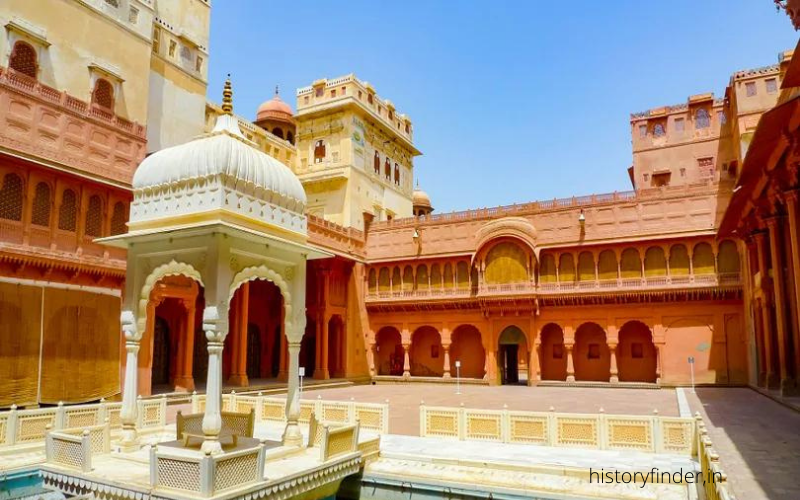
But the present day Karan Mahal differs from the original one made by Maharaja Karan Singh. Maharaja Anup Singh added new floors to the palace during late 17th century. During late 18th or early 19th century, Maharaja Surat Singh also made some valuable contributions to the palace.
The inlaid polychrome glasses, intricate mirror patterns, and red and gold paints were some of the late additions to the palace.

The interior design of Karan Mahal is truly remarkable. Ceiling carvings display exquisite crafting masterclass. Interior walls and columns have exclusive painting with floral designs.
Phool Mahal
Phool Mahal or, the Flower Palace is the oldest construction in the fort. Raja Rai Singh built the palace in 1589, showing his great sense on art and architecture. The decoration of flower vases, rose water sprinklers and motifs adds a unique look to the palace.

The walls of the palace consists of glass and stucco work. Despite of being the oldest palace of Junagarh Fort, the palace still displays Rathore royalty, dignity and prestige of 16th century.
Anup Mahal
Maharaja Anup Singh constructed Anup Mahal for administrative purposes. The multi storied building once was functional as a public audience hall. With his acceptance to Mughal imperiality, Maharaja Anup Singh also became a member of Mughal Durbar.
Maharaja Anup Singh had a great desire of Mughal Diwan-i-Aam which reflects in the architecture of Anup Mahal’s audience hall. The hall only differs in aesthetics, in terms of interior design and its artistry.

Anup Mahal is a multi storied building with remarkable crafting both at its exterior and interior.
The gold leaf painting of Anup Mahal is the most attractive aesthetic of the palace. Italian marble and ornate wooden design works make the palace awe-inspiring. The golden carvings at the ceiling also look marvelous.
Ganga Mahal
Maharaja Ganga Singh constructed the palace in 20th century. Ganga Mahal consists a very large durbar, known as Maharaja Ganga Singh Hall. The hall now houses a museum.

The Ganga Singh hall museum of Junagarh Fort exhibits many war weaponries, paintings, coins etc. Artillery gun, pistols, swords, armors are there in the collection of weaponries. A well maintained biplane of World War I is also displayed in the museum.
Chandra Mahal
Chandra Mahal is famous for the most beautiful and luxurious bed rooms for the royal family. The lavish gold plated decorations with intricate mirror works gives an extremely gorgeous look to the palace. Precious stones were used in the paintings. The gold plated deities of Chandra Mahal are another astonishing artwork of former Chintamani Fort.
Gaj Singh who ruled Bikaner from 1746 to 1787, built Chandra Mahal.

The extravagantly luxurious royal bedrooms were enriched with high security features for the king. Efficiently engineered mirrorwork are high noticeable. The kings could notice if anyone is entering the bedroom, from his bed.
Badal Mahal
Badal Mahal is usually is an extension of Anup Mahal. It houses several paintings of local Shekhawati Dundlod chiefs paying respect to the Maharajas of Bikaner. Some paintings display people standing on nails, wood, swords and saws as a symbol of faith and endurance.
Dungar Singh built the Badal Mahal (the weather palace) during his reign (1872-1887).

The word ‘Badal’ means the ‘cloud’ in Hindi or local Rajasthani language. The walls of the palace displays fine fresco paintings of Lord Krishna and his consort Radha in the rain clouds. Hence the name Badal Mahal.
Bikaneri Havelis
Several mansions appear both inside and outside the fort, on the by lanes in the city, known as Bikaneri Havelis. Considered as the pride of Bikaner, the havelis have an incredible royal look. Exclusive home architecture of Bikaner reflects from these constructions.
Temples in Junagarh Fort
Several Hindu and Jain temples appear inside the largest fort of Bikaner. Some of them are:
Har Mandir
Built in 16th century, Har Mandir is probably the among the oldest and major temples inside Junagarh Fort. Lord Vishnu and goddess Laxmi are the main deities in this temple. Royal family would worship the deities in this temple.
The front portion of the temple was built with white marbles. Beautiful carvings are visible on the temple structure. Back side the temple was however, built with red sandstone.

During the festival of Dussehra, the royal people would worship weapons and horses. Diwali was another majorly celebrated festival in the temple courtyard. Besides these, birthdays and marriage functions of the royal family were also arranged and celebrated here.
Ratan Behari Temple
Maharaja Surat Singh, 18th king of Bikaner, built Ratan Behari Temple during the 19th century. It is is also known as Krishna Temple since Lord Krishna is the main deity of this temple.
Ratan Behari Temple displays a unique mix of Mughal and Indian temple architectures. The main structure of the temple was built with red sandstone while a significant use of white marbles are visible at front and top side of the temple.

Gaj Temple
Gaj Mandir or Gaj Temple is another beautiful temple with beautifully decorated walls. Impressive designs are apparently noticeable on the temple walls. Maharaja Gaj Singh, the 15th ruler of Bikaner, built the temple in 18th century.
Junagarh fort entry fees and visiting hours
Maharaja Raj Singhji Trust maintains the fort and also manages visitor entries. The trust charges fixed entry fees for entering the fort. They charge Rs. 50 to adult Indians and Rs. 300 to the foreigners. However, for students it offers a considerable discount on entry fees. Indian students can enter the fort at just Rs. 30 whereas foreign students have to pay Rs. 150 per ticket.
The trust also takes care of better viewing experience of the visitors. Special tickets are available for video and still cameras.
Junagarh Fort timing for visit
The fort is open for visitors from 10:00 AM to 4:00 PM everyday.

